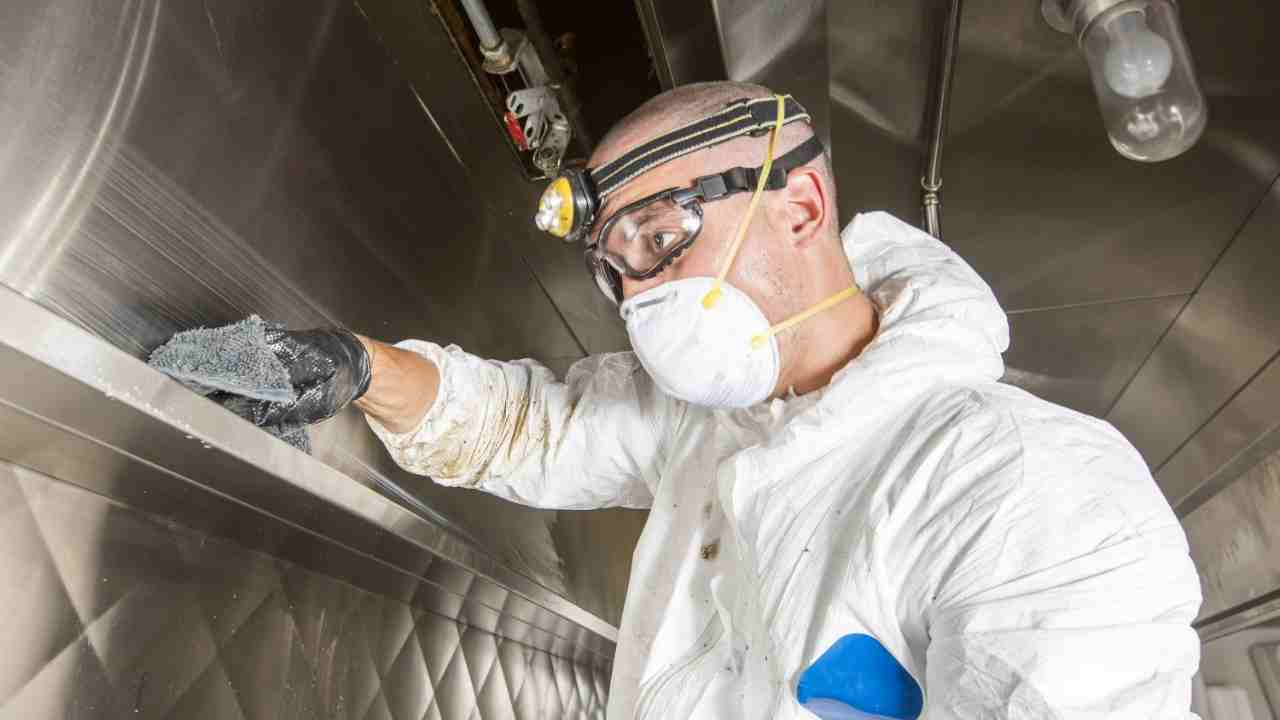Ventilation Cleaning Solutions

Ontario-wide Kitchen Exhaust and Hood Cleaning – Best prices and service guaranteed.
Improving Indoor Air Quality and Energy Efficiency
Indoor air quality is a crucial aspect of any building, whether it’s a residential home, office space, or commercial establishment. Poor air quality can lead to various health issues, including respiratory problems, allergies, and even long-term illnesses. One of the key factors that contribute to indoor air quality is the cleanliness of the ventilation system. In this article, we will explore the importance of ventilation cleaning solutions and how they can improve both indoor air quality and energy efficiency.
The Importance of Clean Ventilation Systems
Ventilation systems play a vital role in maintaining a healthy and comfortable indoor environment. They are responsible for circulating fresh air, removing pollutants, and regulating temperature and humidity levels. However, over time, these systems can accumulate dust, dirt, allergens, and even mold, compromising their efficiency and the quality of the air they circulate.
Dirty ventilation systems can have several negative consequences:
- Reduced Indoor Air Quality: Dust, allergens, and pollutants trapped in the ventilation system can be continuously circulated throughout the building, leading to respiratory problems, allergies, and other health issues.
- Increased Energy Consumption: When ventilation systems are clogged with dirt and debris, they have to work harder to maintain the desired temperature, resulting in higher energy consumption and increased utility bills.
- Potential Fire Hazards: Accumulated dust and debris in ventilation systems can become a fire hazard, especially in commercial establishments where there may be a higher concentration of flammable materials.
- Decreased Lifespan of HVAC Equipment: Dirty ventilation systems can put additional strain on HVAC equipment, leading to more frequent breakdowns and a shorter lifespan.
-
Ontario-wide Kitchen Exhaust and Hood Cleaning – Best prices and service guaranteed.
The Benefits of Ventilation Cleaning Solutions
Regular cleaning and maintenance of ventilation systems are essential to ensure optimal performance and improve indoor air quality. Ventilation cleaning solutions offer several benefits:
1. Improved Indoor Air Quality
By removing dust, dirt, allergens, and other pollutants from the ventilation system, cleaning solutions significantly improve indoor air quality. This is particularly important for individuals with respiratory conditions, allergies, or weakened immune systems.
According to a study conducted by the Environmental Protection Agency (EPA), indoor air can be up to five times more polluted than outdoor air. Regular ventilation cleaning can help reduce the concentration of pollutants and create a healthier living or working environment.
2. Enhanced Energy Efficiency
Clean ventilation systems operate more efficiently, resulting in lower energy consumption and reduced utility bills. When the system is free from dirt and debris, it can circulate air more effectively, maintaining the desired temperature without overworking the HVAC equipment.
A study conducted by the National Air Duct Cleaners Association (NADCA) found that cleaning the ventilation system can lead to energy savings of up to 25%. This not only benefits the environment but also provides significant cost savings for building owners and occupants.
3. Extended Lifespan of HVAC Equipment
Regular cleaning and maintenance of ventilation systems can help prolong the lifespan of HVAC equipment. When the system is clean, it operates more efficiently, reducing the strain on the equipment and minimizing the risk of breakdowns or costly repairs.
According to the American Society of Heating, Refrigerating, and Air-Conditioning Engineers (ASHRAE), inadequate maintenance is one of the leading causes of HVAC system failures. By investing in ventilation cleaning solutions, building owners can protect their HVAC equipment and avoid unnecessary expenses.
4. Compliance with Health and Safety Regulations
In many countries, there are health and safety regulations that require regular maintenance and cleaning of ventilation systems. Failure to comply with these regulations can result in fines, penalties, or even legal action.
By implementing ventilation cleaning solutions, building owners can ensure that their systems meet the necessary standards and provide a safe and healthy environment for occupants.
Ontario-wide Kitchen Exhaust and Hood Cleaning – Best prices and service guaranteed.
Types of Ventilation Cleaning Solutions
There are various methods and techniques used for cleaning ventilation systems. The choice of cleaning solution depends on factors such as the type of system, the level of contamination, and the specific requirements of the building. Here are some common ventilation cleaning solutions:
1. Mechanical Cleaning
Mechanical cleaning involves physically removing dirt and debris from the ventilation system using brushes, vacuums, and other specialized tools. This method is effective for removing loose contaminants and can be used for both residential and commercial systems.
During mechanical cleaning, professionals access the ductwork through access points or by creating small openings. They then use brushes and vacuums to dislodge and remove the accumulated dirt and debris. This method is often combined with negative pressure techniques to ensure thorough cleaning.
2. Chemical Cleaning
Chemical cleaning involves the use of cleaning agents or disinfectants to remove contaminants from the ventilation system. This method is particularly effective for eliminating mold, bacteria, and other microorganisms that may be present in the system.
Chemical cleaning is typically performed after mechanical cleaning to ensure a comprehensive cleaning process. The cleaning agents used are specifically formulated for HVAC systems and are safe for both the system and the occupants.
3. Ultraviolet Germicidal Irradiation (UVGI)
UVGI is a method that uses ultraviolet (UV) light to kill or inactivate microorganisms in the ventilation system. UV lamps are installed in the ductwork or near the cooling coils, where they emit UV-C light that destroys the DNA of bacteria, viruses, and other pathogens.
This method is particularly effective for preventing the growth of mold and eliminating airborne pathogens. UVGI is often used in healthcare facilities, laboratories, and other environments where maintaining high indoor air quality is critical.
Ontario-wide Kitchen Exhaust and Hood Cleaning – Best prices and service guaranteed.
Case Studies: The Impact of Ventilation Cleaning Solutions
Several case studies have demonstrated the positive impact of ventilation cleaning solutions on indoor air quality and energy efficiency. Here are two notable examples:
Case Study 1: Office Building
An office building in a busy urban area experienced a decline in indoor air quality, resulting in increased employee complaints about allergies and respiratory issues. The building management decided to invest in ventilation cleaning solutions to address the problem.
After the cleaning process, the indoor air quality significantly improved, and employee complaints reduced by 70%. The building also saw a 20% reduction in energy consumption, resulting in substantial cost savings.
Case Study 2: Hospital
A hospital was facing challenges in maintaining a sterile environment due to mold growth in the ventilation system. This posed a significant risk to patients with weakened immune systems. The hospital implemented a combination of mechanical cleaning and UVGI to eliminate the mold and improve indoor air quality.
Following the cleaning process, the hospital experienced a significant reduction in mold growth and a decrease in hospital-acquired infections. The ventilation system’s energy efficiency also improved, resulting in lower utility bills.
Ontario-wide Kitchen Exhaust and Hood Cleaning – Best prices and service guaranteed.
Ventilation cleaning solutions are essential for maintaining a healthy indoor environment and improving energy efficiency. By removing dust, dirt, allergens, and other pollutants from ventilation systems, these solutions enhance indoor air quality, reduce energy consumption, and extend the lifespan of HVAC equipment.
There are various types of ventilation cleaning solutions, including mechanical cleaning, chemical cleaning, and UVGI. The choice of solution depends on factors such as the type of system and the level of contamination.
Case studies have shown the positive impact of ventilation cleaning solutions, with improved indoor air quality, reduced health issues, and significant energy savings.
Investing in ventilation cleaning solutions is not only beneficial for the occupants’ health and comfort but also for the environment and the overall sustainability of buildings. Regular maintenance and cleaning of ventilation systems should be a priority for building owners and facility managers to ensure a safe and healthy indoor environment for all.
Learn more about “Kitchen Exhaust Filter Systems” right here.
Learn more about Ventilation Cleaning Solutions.

What are ventilation cleaning solutions and why are they necessary?
Ventilation cleaning solutions refer to products, procedures, and services used to clean and maintain ventilation systems. These can range from chemical cleaners, steam cleaning tools, automated duct cleaning equipment, and professional cleaning services. The primary aim of these solutions is to remove dust, dirt, allergens, mold, bacteria, and other contaminants that can accumulate in your ventilation system over time.
These solutions are essential for a number of reasons. They help maintain the efficiency and longevity of your ventilation system, reducing energy costs and potential repair expenses. They also help ensure the air quality in your home or business, reducing the risk of respiratory issues, allergies, and other health concerns related to poor indoor air quality. For commercial kitchens, clean ventilation systems also reduce the risk of fire hazards due to grease and fat accumulation.
What are the different types of ventilation cleaning solutions?
There are several types of ventilation cleaning solutions, including:
Chemical Cleaning Solutions: These involve the use of chemicals to break down and remove dirt, dust, and other contaminants from your ventilation system. They often come in spray or foam form and can be applied directly to the system components.
Mechanical Cleaning Tools: These include brushes, vacuum systems, and other tools designed to physically remove dirt and debris from your ventilation system.
Steam Cleaning Solutions
: These use steam to dissolve grease, kill mold and bacteria, and remove other contaminants from your ventilation system.
Professional Ventilation Cleaning Services: These services use a combination of specialized tools, techniques, and experience to thoroughly clean your ventilation system.
Each solution has its own advantages and is best suited to different situations. The best choice will depend on your specific ventilation system and the nature of the contaminants that need to be removed.
How often should ventilation systems be cleaned?
The frequency of ventilation cleaning depends on several factors, including the type of system, the environment in which it operates, and its usage. For residential HVAC systems, the National Air Duct Cleaners Association (NADCA) recommends cleaning every 3-5 years. However, if you have pets, smoke indoors, have recently renovated or moved into a new home, or have family members with allergies or asthma, more frequent cleaning may be beneficial.
Commercial ventilation systems, especially in kitchens, should be cleaned more frequently due to higher usage and the accumulation of grease and other combustible materials. The National Fire Protection Association (NFPA) recommends cleaning commercial kitchen exhaust systems at least every six months, but potentially as often as monthly for high-volume cooking operations.
Can I clean my ventilation system myself, or should I hire a professional?
While basic maintenance and cleaning can be done by homeowners, such as replacing filters and cleaning accessible parts of the ductwork, a thorough cleaning of a ventilation system is best left to professionals. This is because a professional has the necessary training, tools, and experience to clean the system thoroughly without causing damage.
Professional ventilation cleaning services use specialized equipment to reach deep into your ventilation system and remove all dirt and contaminants. They also know how to handle potential hazards such as mold and bacteria and can assess the overall condition of your system to identify any potential issues.
Are there any regulations that govern ventilation cleaning?
Yes, there are several regulations and guidelines that cover ventilation cleaning, particularly in commercial settings. For example, the NFPA provides guidelines for the cleaning of commercial kitchen exhaust systems to reduce the risk of fire.
For residential systems, while there may not be specific regulations, there are industry standards set out by organizations such as NADCA. These standards provide guidelines for the proper cleaning and maintenance of residential HVAC systems.
It’s important to ensure that any professional ventilation cleaning service you hire is aware of and adheres to these regulations and standards. This not only ensures the job is done right but can also help you avoid potential fines or legal issues.







